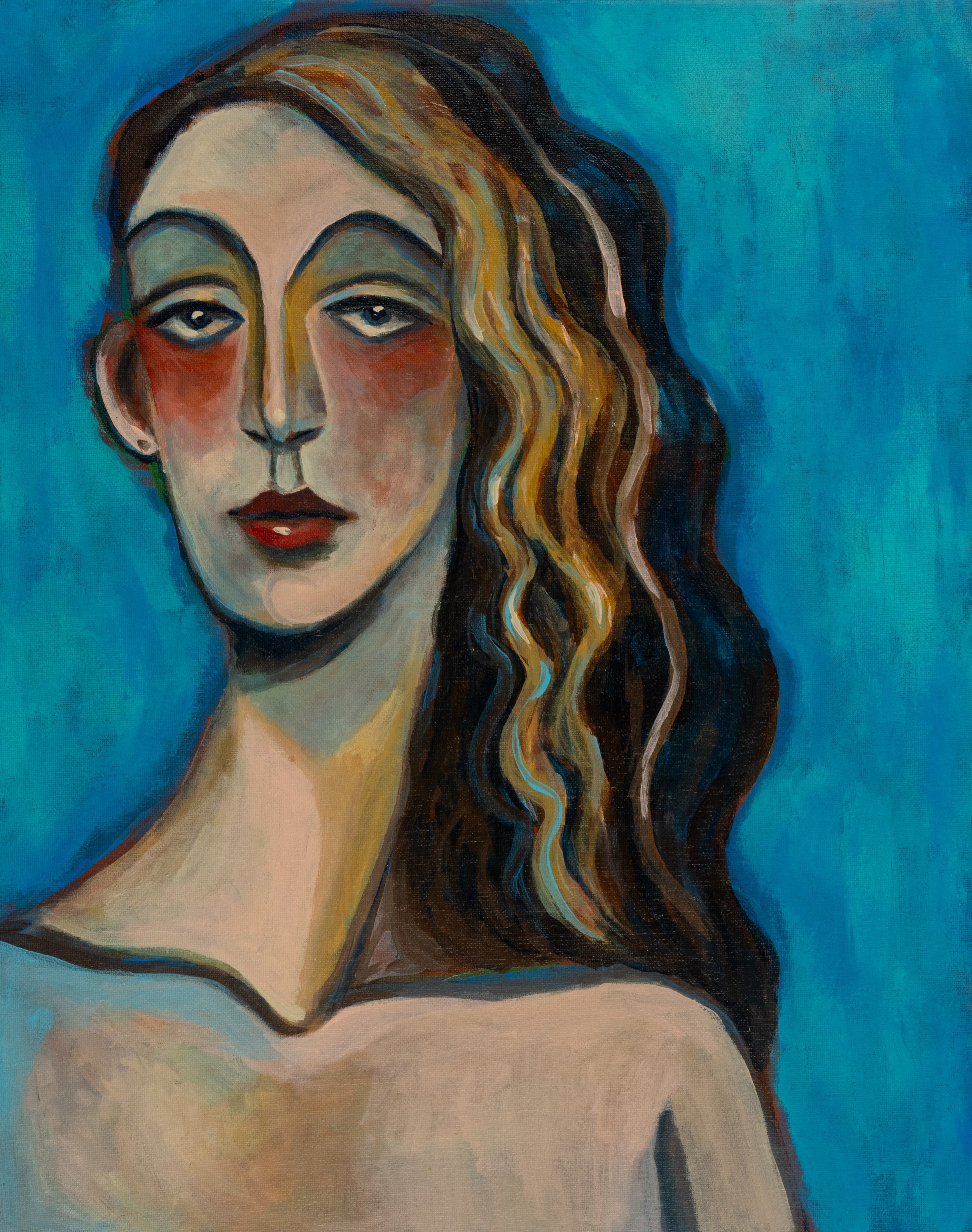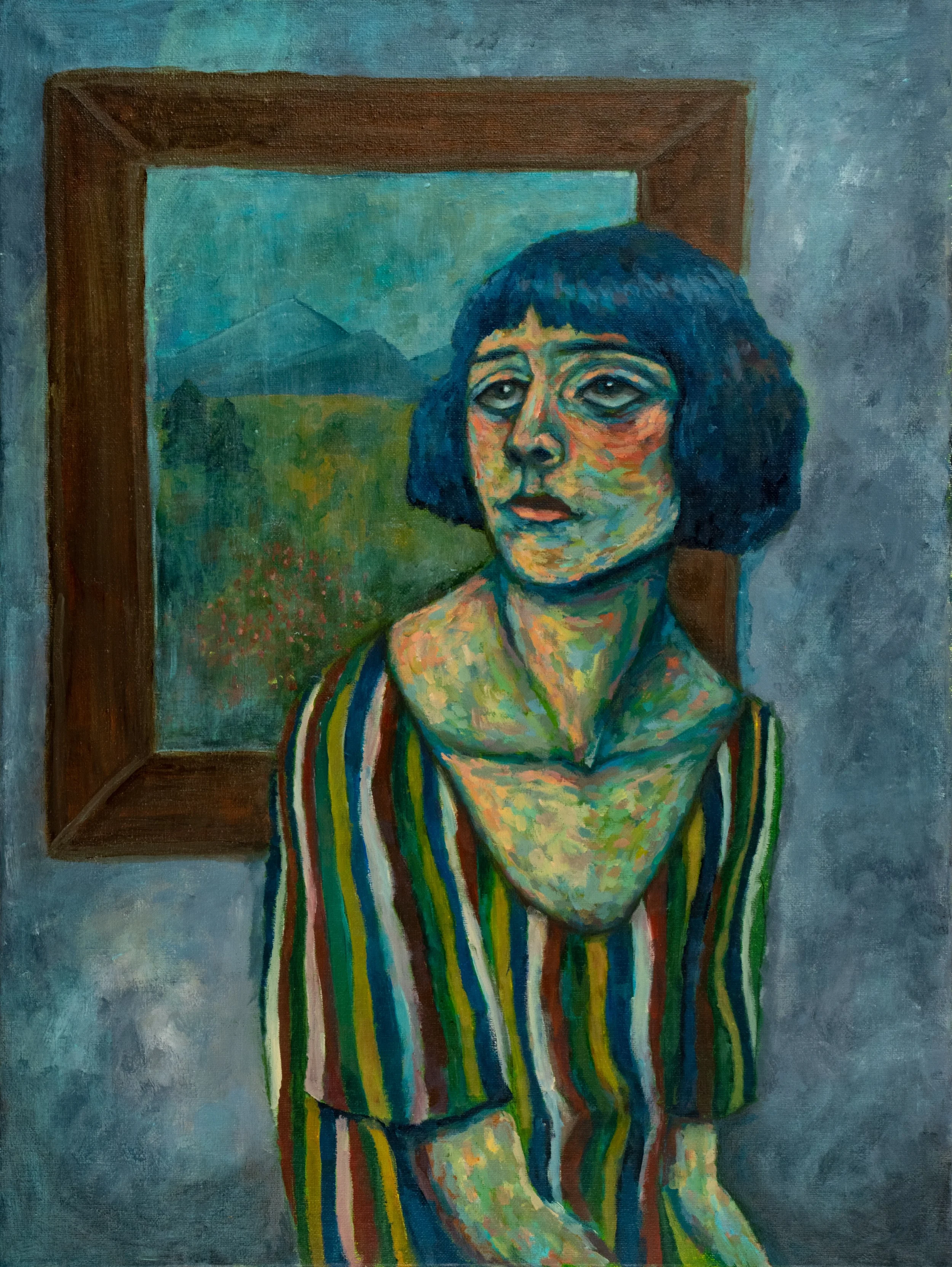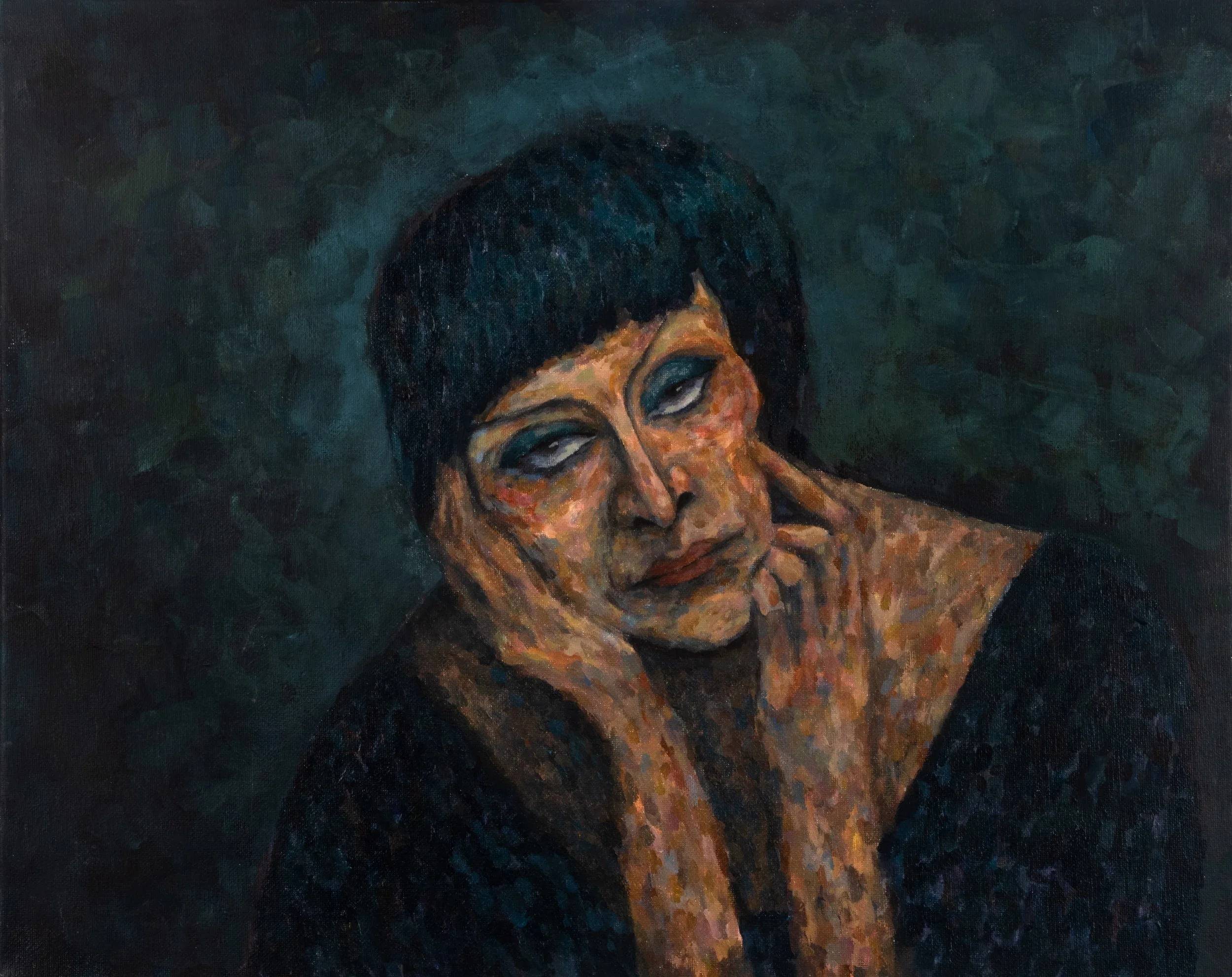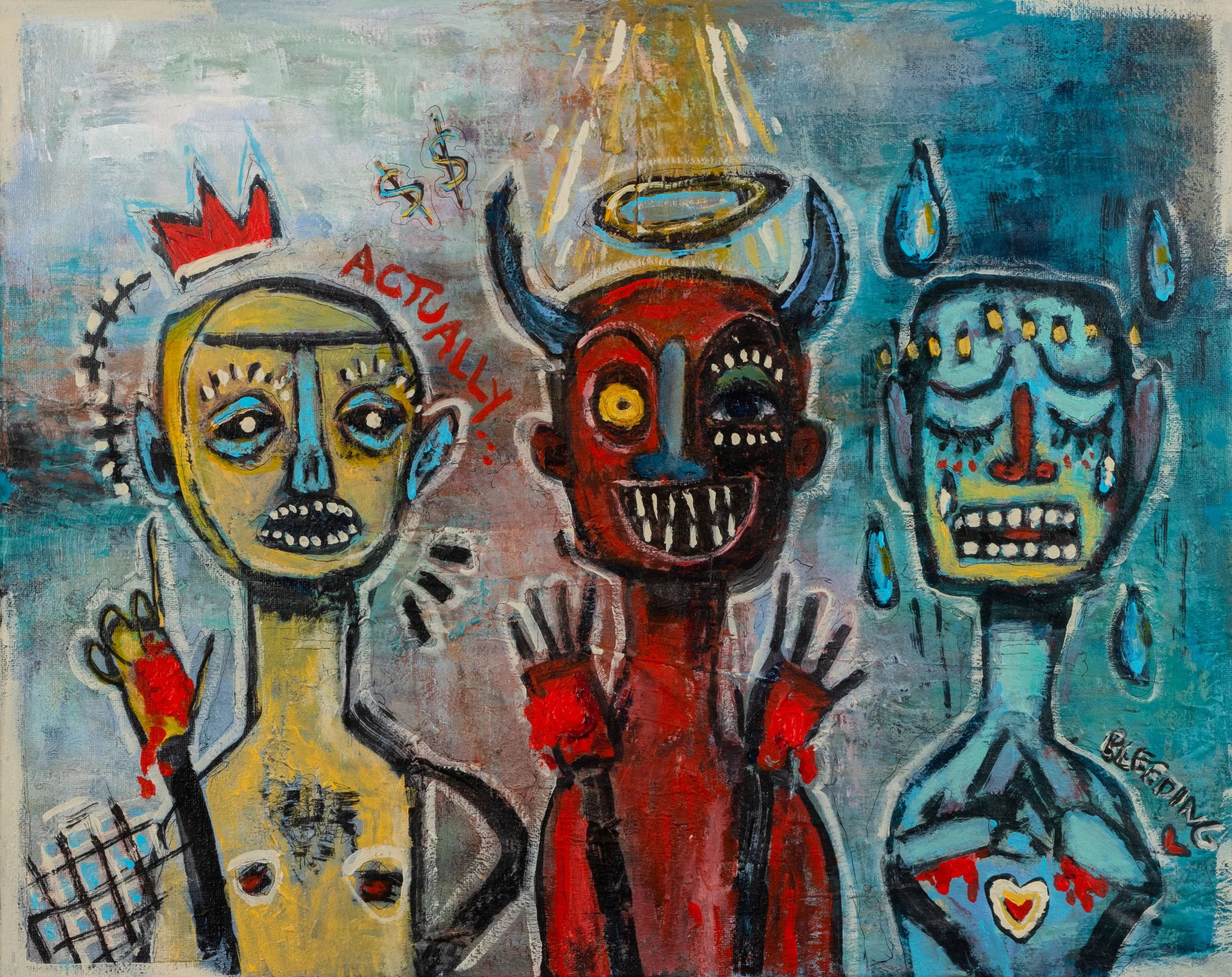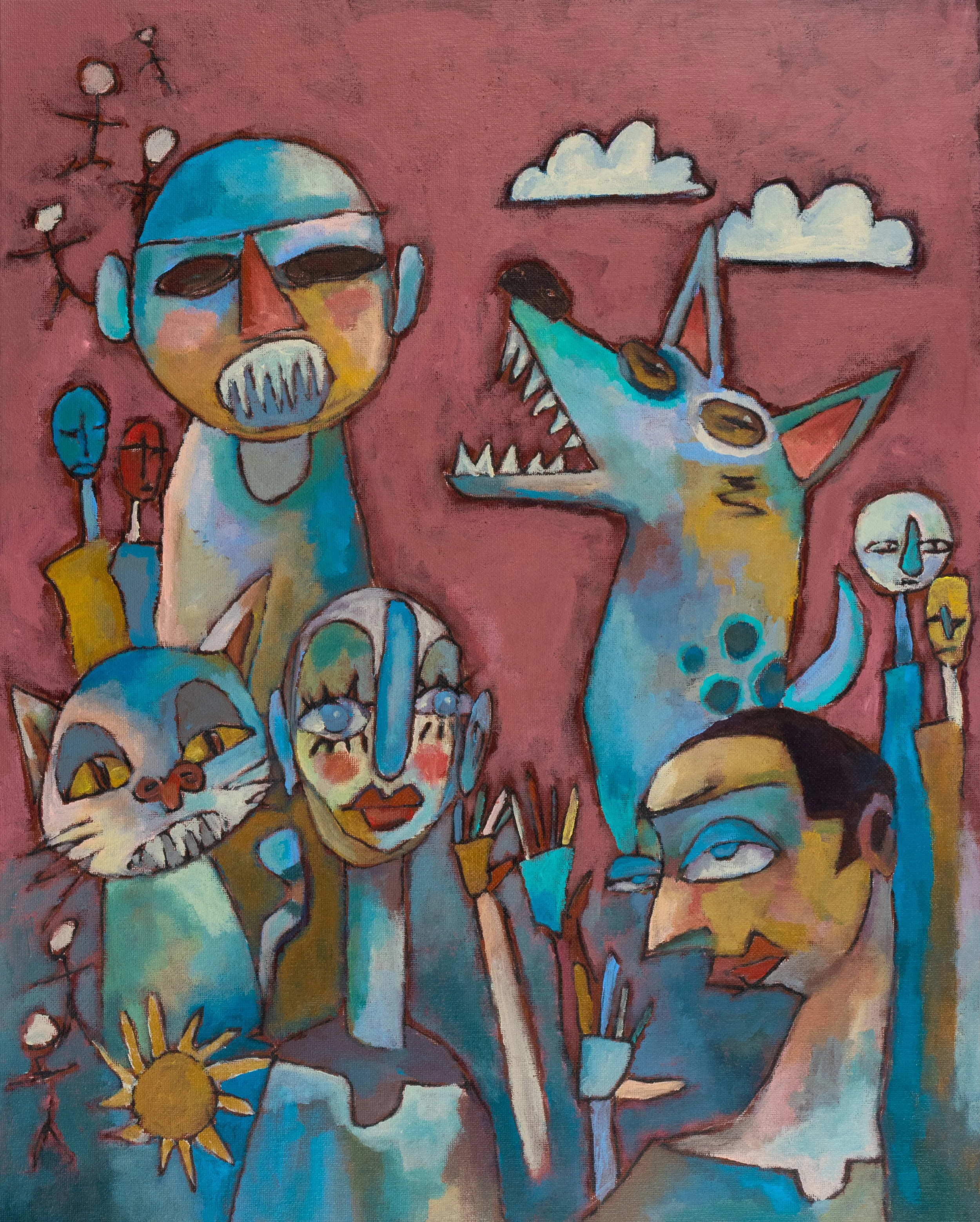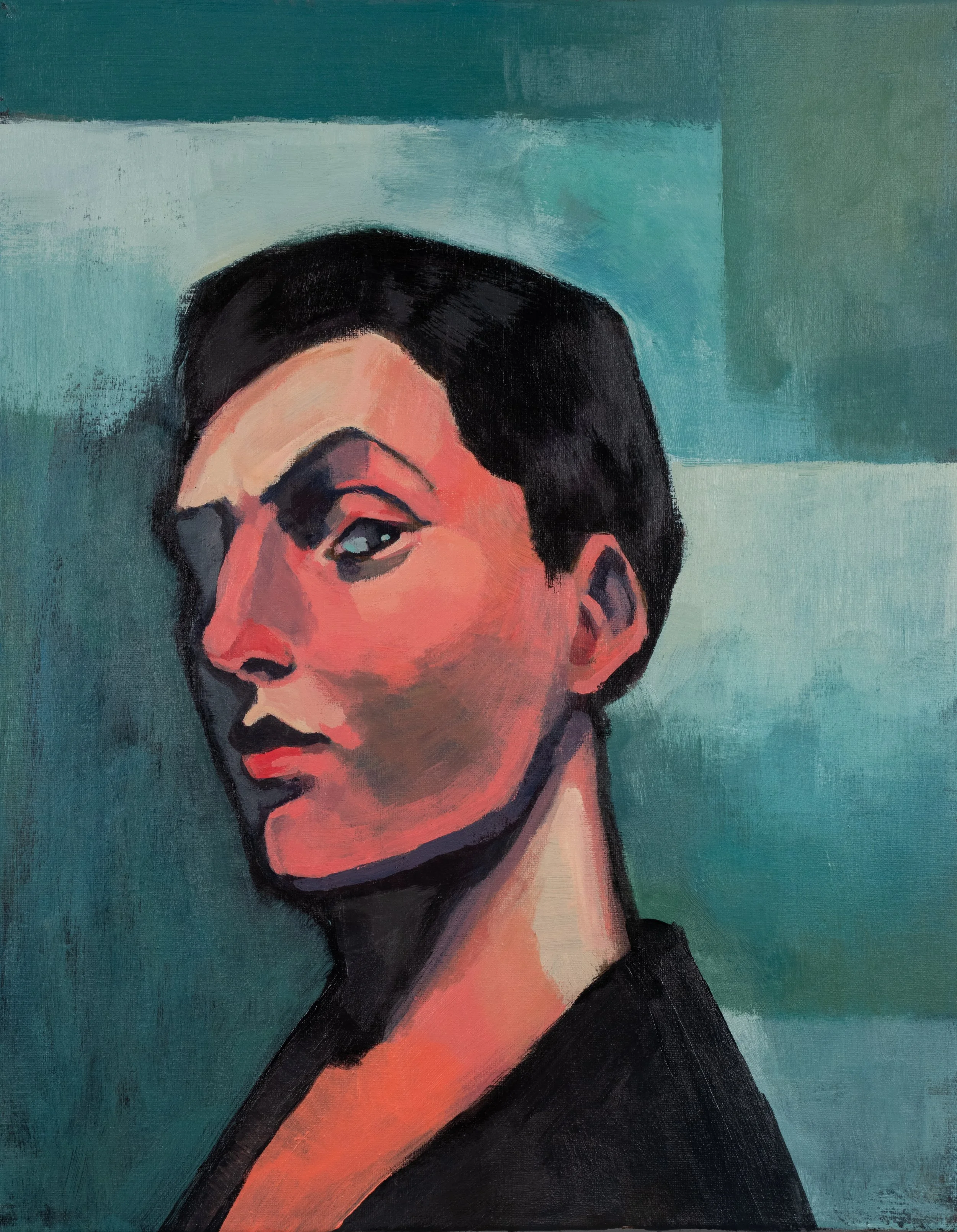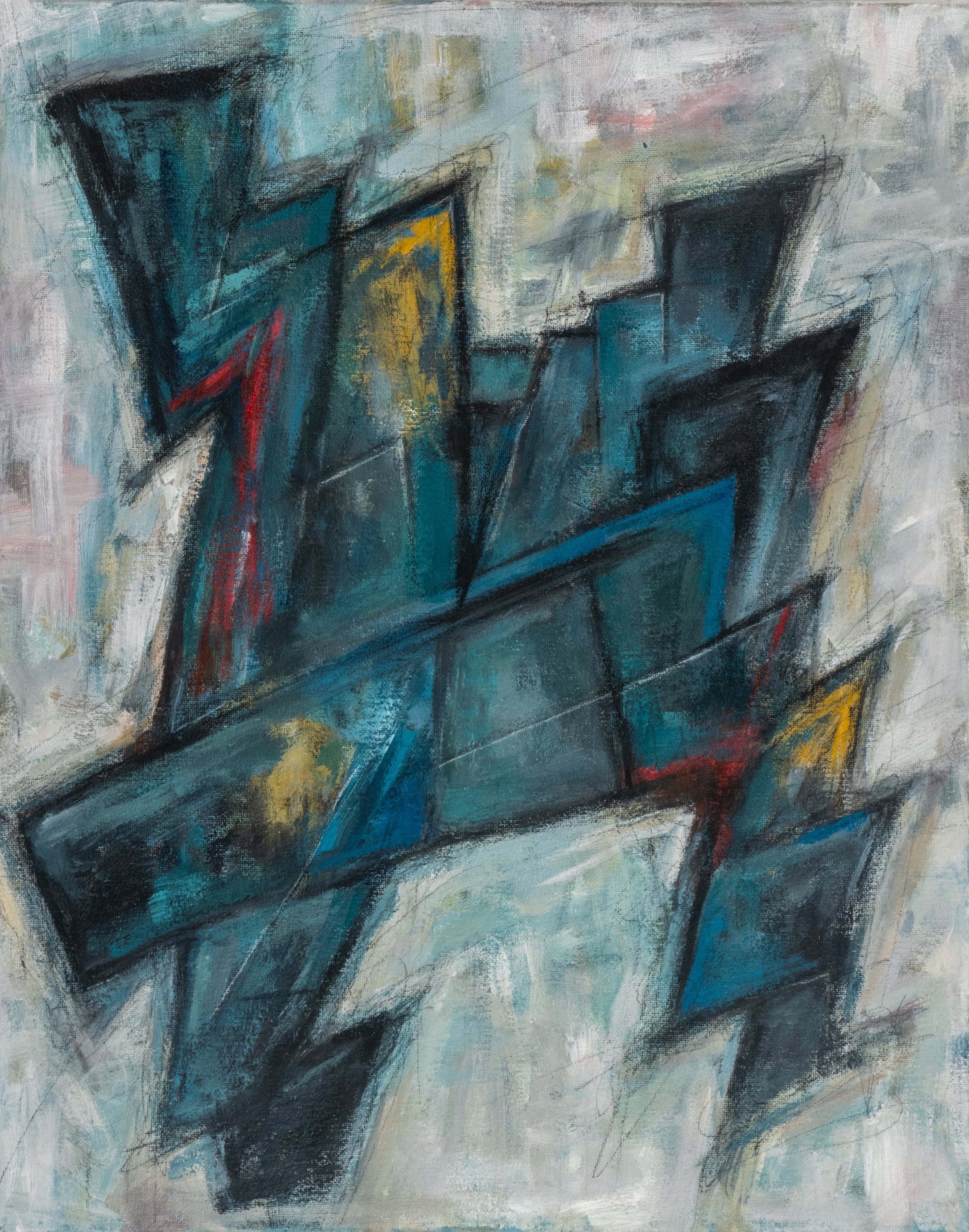The Self In Blue
This is one of the few self-portraits I have ever done that has portrayed myself in a positive light. Admittedly, I often only feel comfortable painting myself as grotesque or in the midst of some kind of emotional struggle. It is not often that I paint myself as serene and pleasant like I did in this piece. I have struggled often with finding the worth in myself, and I did this as a way to find it. It was difficult; I actually changed course several times during the painting because I struggled with the concept. It felt like the person in the painting was too confident, too content, too self-assured to be me, and it took many nights before I was finally able to paint the finishing touch: the distinctive curly, side-parted hair that definitively makes this subject “me”.
Pareidolia
par·ei·do·lia | “the tendency to perceive a specific, often meaningful image in a random or ambiguous visual pattern; the human ability to see shapes or make pictures out of randomness”
I am interested in how humans often find ourselves where we do not belong: in tree trunks, in clouds, or in burnt toast. With just a few vague strokes, we can easily perceive a human shape. I hope to push this concept further and see when the viewer is finally unable to perceive anything from an image. Abstract paintings are fascinating in this sense: even when the artist does not intend there to be any discernable representations in the piece, viewers often are able to pick out things that aren’t there.
Stay Far
A companion piece of Pareidolia.
I tried to encompass the simultaneous fear and sadness at the need to be loved. A fear of disappointment pulls one away from connection while the longing for it is heartrending. The instinct to be loved is coupled with the terror of getting too close.
Isolation
I often do not start a piece with a meaning in mind, but this one evolved a meaning quite quickly. I used a reference photo from the 1910s, and the woman’s bobbed hair and loose dress evokes that time period. I began to think of the parallels between today and post-Spanish Flu America— both are times of significant technological advancements coupled with a worldwide pandemic, two aspects of modern life that have brought isolation. In the 1910s, automobiles became widespread, more communicated through telephone, and people moved to the cities for work in the more modern sectors of society. This of course occurred concurrently with the Spanish Flu and the lockdown measures that were in place. Both of these changes in society evoke a sort of loneliness and separation from others that was not common in previous generations. Modern day society suffers similar ills— advancements in technology have brought worldwide social networks, interconnectivity, and ways to work anywhere in the world from home. All serve to bring us together but very rarely succeed in doing so. Coupled with two years of lockdowns, quarantines, and travel bans, we all seem acutely aware of how painful loneliness can be and how quickly communication can be severed. This piece seeks to connect the two time periods, showing a woman in isolation sitting in front of the seemingly accessible outside world.
Do I Make You Uncomfortable?
I wanted to capture an image of a woman looking at you from across a smoky bar, unflinchingly staring only at you despite the bustle around her. I wanted to evoke something uncomfortable in the viewer, as if she is observing you rather than you observing her. When the viewer approaches her, I want them to be the one watched, not her. In this sense, this piece plays upon the objectification of women in art. Female subjects have historically often been playfully coy, averting their eyes from the viewer or turning their head away. The coquettish, unintimidating, sexy woman in art lacks agency and power and serves to be looked upon as an object of desire, often by a male gaze. I wanted to turn this on its head. I do not know if the subject of this piece desires the viewer or is merely challenging them, but I want her to be undeniably authoritative in her gaze.
Hypochondriac
In 2020 just before the pandemic, I became a full-blown hypochondriac. The stress of this ended up leading to my TMJ disorder, which only worsened the anxiety I felt about my body. In the process of trying to figure out what was wrong with me, I did nearly every imaging test available: MRI, CT, X-Rays, CBCT. I spent months obsessively mulling over the imaging scans as doctors gave me a variety of potential reasons for my condition: a constricted airway, nasal valve collapse, TMJD, tardive dyskinesia, spinal stenosis, Ehlers Danlos syndrome, POTS, myofascial pain syndrome, Meniere’s disease. I now know that I had merely created the condition myself through excessive stress and anxiety, and unfortunately am still dealing with symptoms today because of it (though to a much lesser extent). This piece represents the constant, unbearable awareness of every bodily feeling at once, inspired by the pictures I saw on the imaging.
The Discoursers
At the time I made this, the United States was deep in the midst of political discussion over Trump and his policies. As we were still largely homebound from the pandemic, I only ever witnessed these discussions online, where conversation is rarely productive. I observed three distinct types of people in the online discourse of politics, represented left to right in the painting. First is the contrarian, who will refute absolutely everything presented to them, regardless of the other side’s fair points. They might be a troll or they might simply hate their conversation partner and their views. The second is the devil’s advocate, who refuses to make their own position clear and instead always argues that there must be a fair reason for injustice if only we look to the other side. This person probably does not actually have the knowledge to form their own opinion. Finally, there is the bleeding heart, who expresses sympathy— “thoughts and prayers”— but remains uncomfortable doing anything material to resolve the actual problem. Every one of them is effectively useless in debate. This piece is inspired by neo-expressionism, a style that I feel is very effective in conveying political messages.
Stream of Consciousness
I am always fascinated by the meaning we give to art, particularly how the viewer and artist often differ in their interpretation. Because of its focus on meaning (or lack thereof), surrealism has long been an inspiration. I thought it was interesting that viewers of surrealist art are often able to assign profound meaning to pieces that are meant to be as devoid of meaning as possible. Even when the artist tries to make it nonsensical, it never is truly without meaning.
In this piece, I attempted to paint without paying any mind to meaning, composition, or pattern. I make most of my work intuitively and organically, but I really tried to push myself to think of absolutely nothing when making this. I laid down colors and shapes, keeping my brain as silent as I could. It was an exercise in meditation and mindfulness; I struggled to keep myself from mulling over the composition and subject matter and often had to force myself back to the present moment.
Judgment
A study using large brushes that quickly turned into a fully fledged portrait. I was expecting a meaning to come to me as I painted this, but I was admittedly distracted by the fact that I was filming my painting process for this piece. This is one of the downsides to showing your art online; you have to sacrifice some of the normal, lonely process of painting in private. It’s almost like having an audience. That’s when the meaning struck me: he is watching and so are you. You are now a part of my process, and I am aware of it, and now perhaps you are too.
Adjoining
I used to not understand abstract art. I used to utter the common phrase, “I could do that”. I said this until I actually tried abstract art and found that it was much more difficult than portraiture and required much more knowledge of theory than I had anticipated. Breaking down art to its bare fundamentals of composition, color, line, form, value, etc. proved to me that I still had a lot to learn as an amateur artist.
This is one of the first pieces I made that I was proud enough to show publicly. This was over a year after I first dipped my toes in and tried the waters of non-representative work.
In-Sight
My favorite things to draw are busts – there is something classical and interesting about them. This figure without irises calls to mind Greek marble busts or perhaps even some of Modigliani’s blank eyed women. I decided to use a very large, square brush for this piece because I wanted the colors and values to be blocked in and deliberately rough. I often do not use many curved lines in my works because I prefer a more painterly and textured look, and I think this piece exemplifies that.
Smatter
I started doing abstract art for the first time in May 2020 following what can only be described as a mental break. I had not done art seriously for many years at that point, as I had gotten the idea that I had to master the artistic fundamentals before diving deeper into creative works. I tried my hand at academic art for a while until eventually it became a chore rather than a passion. It halted my love of art for many years until it became clear that art was the only thing left that could save me from going down a very dark road mentally.
With my new advice to explore art creatively rather than from a technical perspective, I tried my hand at abstract for the first time in my life. My first attempts were objectively terrible but fulfilled their purpose of expressing something from within myself that desperately needed to be said. This is one of my more emotional abstract pieces and represents a period of psychological healing through the chaos of art.
The Blue Expression
I have long had a love of silent film and the period of the 1900s to the late 1920s. I want much of my work to convey this passion and evoke a sense of nostalgia for a time I did not experience. This piece is inspired by the set design of the film The Cabinet of Dr. Caligari, a 1920 German expressionist film. I loved silent film and pre-Depression history far before my foray into expressionist art, and it only seemed natural that I would eventually explore the visual arts of the turn of the century as well.

